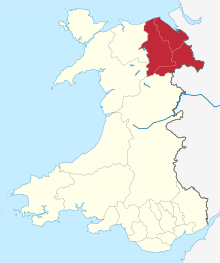North East Wales
North East Wales (Welsh: Gogledd-Ddwyrain Cymru) is the north-easternmost region of Wales. It covers the principal areas of Denbighshire (Welsh: Sir Ddinbych), Flintshire (Welsh: Sir y Fflint), and Wrexham County Borough (Welsh: Bwrdeistref Sirol Wrecsam), together comprising most of the preserved county of Clwyd. It is bordered by North West Wales (Conwy, and Gwynedd) to the west, Mid Wales (Powys) to the south, the English counties of Cheshire, and Shropshire to the east, and the Irish Sea, and Dee estuary to the North. It is the more urban and industrial part of North Wales, centred on the town of Wrexham, Rhyl, and Prestatyn, and the conurbation of Deeside. The region's close links with North West England ("Mersey-Dee"), are crucial to the region's economy. The Clwydian Range and Dee Valley Area of Outstanding Natural Beauty is located in the region. Other attractions include: historical buildings such as; Chirk Castle, and Erddig in Wrexham, valley towns such as; Corwen, and Llangollen, and the Pontcysyllte Aqueduct and Canal World Heritage Site[1].

The North East Wales Metro is a transport improvement project for the region, it is in concept, a multi-modal system with a combination of bus, heavy rail and light rail services linking major settlements and employment areas of the region, with hubs located in Wrexham, Chester and Deeside, in addition to further connections to Liverpool[2]. The economic strategy for the region is for the further integration of North Wales, with Northern England, as part of the Northern Powerhouse project.
Usage and definition
The term North East Wales is used by the Welsh Government in the Wales Spatial Plan[3] and the BBC.[4] Some rarer definitions of North East Wales, only included Flintshire and Wrexham. It is mostly used as a regional grouping of local authorities.
The North East Wales NHS Trust existed from 1 April 1999 to 1 July 2008, when it merged with Conwy & Denbighshire NHS Trust to form the North Wales NHS Trust.
Proposed council(s)
In April 2013, it was announced that a major review was to be undertaken into the organisation of local government in Wales. A report on the findings was released on 20 January 2014. It recommended that the number of councils in Wales be reduced, through mergers rather than through boundary changes, from the current 22 to either 10, 11 or 12. In November 2015, a draft local government bill, presented by the Welsh Government, contained two proposals, a 8 and 9 local authority model.
As part of the proposed eight local authorities model, the 3 existing local authorities of North East Wales, would be combined into one authority, spanning all of North East Wales and therefore most of the former county of Clwyd. Although, no name was proposed for this county.[5]
The alternate proposal, a 9 local authority model, applies to a part of North East Wales, in which Denbighshire would be merged westwards with Conwy instead, leaving the remaining council spanning only Flintshire, and Wrexham.
In January 2017, the proposals for local authority mergers were formally dropped following the publication of a white paper, with the number of councils to remain at 22, unless two or more local authorities wish to pursue a voluntary merger. Instead, proposals for the formation of regional bodies to encourage better collaboration between existing local authorities, was put forward.
Although, a subsequent 2018 green paper made the case for a reduction of the number of local authorities from 22 to 10 and suggested three possible approaches, a system of voluntary mergers, a phased approach with authorities merging in either 2022 or 2026 or a comprehensive system of mergers to occur in 2022. In relation for North East Wales, it followed the former 9 local authority model, with Conwy-Denbighshire and Flintshire-Wrexham[6].
The Local Government and Elections (Wales) Bill, 2019, lacked any provisions on restructuring local councils but did contain mechanisms that will allow two or more authorities merge on a voluntary basis. It also aims to create a framework for joint regional coordination between local authorities.
References
- "Natural Resources Wales / Introduction to North East Wales Area Statement". naturalresources.wales. Retrieved 2020-09-17.
- "North Wales Metro | Transport for Wales". trc.cymru. Retrieved 2020-09-18.
- Welsh Government - The Wales Spatial Plan Update 2008
- BBC North East Wales
- "Councils 'to be reduced to eight'". BBC News. 2015-06-16. Retrieved 2020-09-17.
- "New attempt to cut the number of Welsh councils". ITV News. 2018-03-20. Retrieved 2020-09-17.